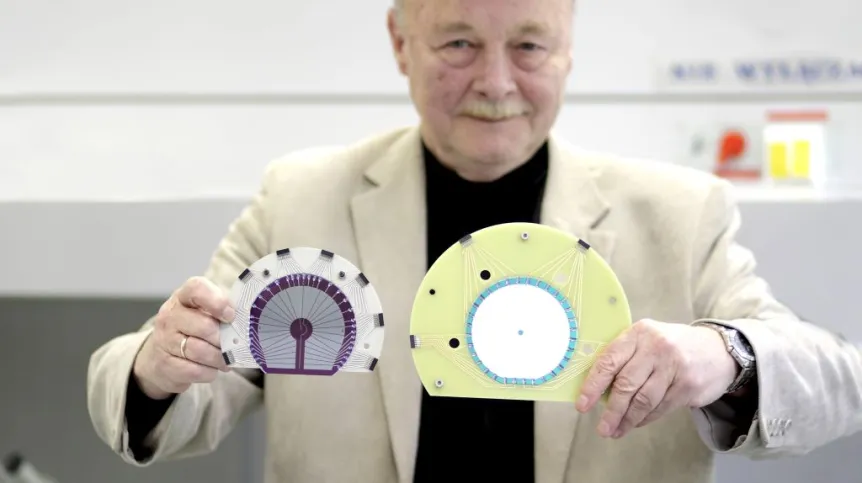
The element with atomic number 117, synthesized a few years ago in Russia, has bee resynthesized at German centre in Darmstadt. Silicon strip detectors from the Polish institute were used in the research project.
Due to the short life, the element 117 does not occur in nature and can only be produced artificially. According to the Institute of Electron Technology in Warsaw (ITE) press release sent to PAP, the first reports on synthesising and observation of element 117 appeared in 2010 after an international experiment carried out in the Russian Institute for Nuclear Research in Dubna. In accordance with common scientific practice, these reports required independent confirmation, which has not been provided until now.
Researchers at the GSI Helmholtz Centre for Heavy Ion Research (German: GSI Helmholtzzentrum für Schwerionenforschung GmbH) in Darmstadt proved the existence of element 117. The achievement, described in the prestigious scientific journal "Physical Review Letters", is the result of the work of physicists, chemists and engineers from 11 countries, including Poland. Observation of nuclear particles indicating the presence of atoms of the new element was possible with silicon strip detectors developed by researchers from ITE.
A key role in the production element 117 has a shield made of high- purity berkelium isotope Bk-249. Half-life of the radioactive metal is only 330 days. Shield material was provided by famous Oak Ridge National Laboratory (ORNL) in the U.S., which produced 13 milligrams of berkelium in 1.5 years. In Darmstadt, berkelium shield was bombarded with heavy calcium ions. From huge cascades of emerging nuclear particles, scientists captured individual atoms of element 117 and observed its degradation products. The parameters of used particle detectors were important for the success of the experiment.
Silicon detectors of charged particles, designed and manufactured at ITE in collaboration with researchers from Munich and Darmstadt, have been specifically designed for the FPDB (Focal Plane Detector Box) of TASCA (TransActinide Separator and Chemistry Apparatus). FPDB consists of three different configurations of detectors made in ITE: the main detector (called stop detector), the detectors recording the particles reflected from the main detector, and another detector recording light ions that have passed the main detector.
In FPDB, atoms of element 117 in the alpha decays transformed into lighter elements with atomic numbers 103 to 115, among which researchers identified a new isotope Lr-266 Lorens, of the element with atomic number 103. Precise registration of generated alpha particles enabled the reconstruction of decay chains and identification of their source. The source were atoms of element 117.
"Thanks to the excellent cooperation with colleagues from Germany, especially with Dr. Alexander Yakushev from GSI, we have developed a set of detectors with optimal parameters for the study of transuranium elements" - emphasized of the silicon detectors team in ITE, Eng. Maciej Węgrzecki.
Warsaw semiconductor devices for the detection of alpha and beta particles and protons are proprietary solutions of scientists and engineers from ITE, protected by patents. "These devices have gained worldwide recognition. They are used in the world\'s major research centres to conduct studies of transuranium elements" - ITE announced. They helped discover heavy nuclei, including the isotope 283 of element 112 (Copernicium, Cn) in Dubna, and isotopes 270, 271 and 277 of the element 108 (Hassium, Hs ) in Darmstadt. In 2009, in Darmstadt they were used to register a record single experiment number of thirteen nuclei of isotopes 288 and 289 of the element 114 (Flerovium, Fl).
The experimental results obtained using the ITE detectors are subject to several frequently cited publications in reputable scientific journals. The studies described in these publications had an impact on the International Union of Pure and Applied Chemistry and the International Union of Pure and Applied Physics decisions to recognize elements 112 and 114 as existing and add them to the periodic table.
In 2012, ITE silicon detectors were awarded in the competition "Polish Product of the Future" and won Gold Medal in the category of "Science for the economy" at the Poznań International Fair.
According to ITE director Zbigniew Poznański, silicon detectors are one of the specialties of the institute. "With its unique technology and many years of experience we are able to make detectors with parameters beyond reach of other companies. This is why we are a valued partner of one of the world\'s leading nuclear research centres" - noted the director of ITE.
PAP - Science and Scholarship in Poland
lt/ agt/ mrt/
tr. RL













